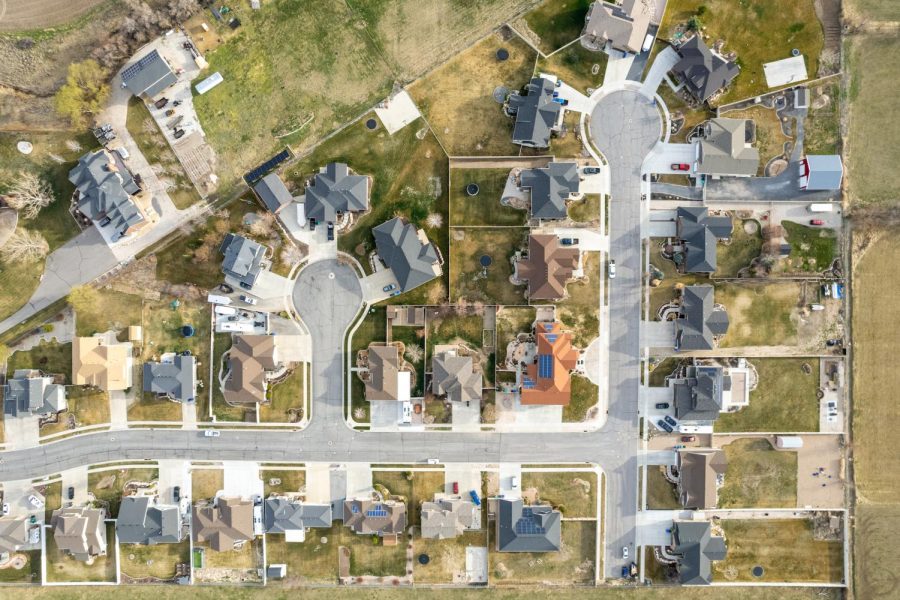Bringhurst: Utah’s Housing Crisis Leaves Students Behind
A residential area in Hooper, Utah on March 26, 2022. (Photo by Xiangyao “Axe” Tang | The Daily Utah Chronicle)
April 19, 2022
Utah’s housing affordability crisis is a pressing issue. Rent is going up, and homeowners have been priced out of their homes. University of Utah students must choose between living in dorms or renting, and neither option is affordable. Some have even opted to live in their cars. The combination of the pandemic and the already unstable housing market has schools across the country grasping for solutions.
On-campus housing should exist to provide an affordable living option for students, but that isn’t the case at the U. Some students find renting with inflated prices to be more affordable than living on campus. The U needs to do more to accommodate students’ housing needs.
The Reality of On-Campus Housing Options
Southern Utah University made headlines in March after asking students to live with relatives or take online classes simply because there wasn’t enough housing in Cedar City to accommodate all the students enrolled for fall 2021. Utah State University faced a similar situation. The steady increase in enrollment rates coupled with Utah’s housing shortages could have made this easy to identify, but it wasn’t addressed until it was too late.
The U surpassed its largest total enrollment in history for the fall 2021 semester, but housing is not increasing at the same rate. Enrollment of first-time freshmen, who are more likely than other students to live on-campus, increased by 19.6%.
According to the U’s online rate estimator, the most affordable on-campus rooms typically cost around $7,000 per academic year. Freshman rates are lower on average, but a mandatory meal plan brings the total to a similar price. Most students would have to pay that per semester in addition to tuition, but a payment plan may bring it to $875 a month. Compared to Salt Lake City’s median price of $1500 for a two-bedroom apartment, or $781 per person with a roommate, on-campus housing is more expensive than the current rental market.
Student Renters
88% of students at the U live off-campus. Many of those students are renters navigating the costly price to live in Salt Lake City. In the past five years, rent in Salt Lake City increased by 52%. One in five Utah renters spend more than 50% of their income on rent. To qualify for government financial assistance like rental relief, renters must meet certain criteria that don’t take students into consideration.
Before students can even consider the financial strain of renting, they must be approved for an apartment. Housing application requirements often include barriers to students like minimum credit scores, proof of income three times the rent and prior rental history. The U provides no support for overcoming these obstacles.
The U doesn’t have financial aid programs for student renters. Instead, students resort to either need-based or performance-based grants on top of student loans. For off-campus students like me, this assistance doesn’t touch my rent. It barely covers the help I need for tuition. My landlord, like many others, is preparing to increase rent. Though this impacts my ability to pay tuition, the U hasn’t addressed this current housing environment for students.
Possible Solutions
Colleges across the country struggled to house students for the fall 2021 semester. The University of Tampa offered financial aid to students who struggled to find housing. Aid included one-time grants of $2,000 for students who intended to live on campus but never got past the waiting list. They also provided $3,500 per year to students who deferred enrollment, allowing the university to catch up without disregarding student needs.
UVU’s Off-Campus Housing and Residence Life aims to help students navigate off-campus housing. They offer a Residential Community Leadership Program that provides support and engagement with students who live off-campus and offers full-housing scholarships for student leaders.
The U is constructing a new residential building to keep up with enrollment demand, but it won’t necessarily be affordable. Rent will go to scholarship funds, which may help a few lucky students, but ignores the affordability of the issue as a whole.
At the very least, the U should provide a designated housing resource office for off-campus students. As a commuter school, housing is a concern for the 88% of students who live off-campus.
The strain of the current rental market on students warrants support from the university. If Housing and Residential Education doesn’t tackle this problem from the perspective of a student renter, no one will. The U needs to do more to provide affordable housing for students, especially as the city leaves us behind.









